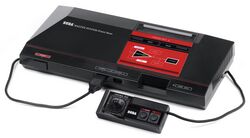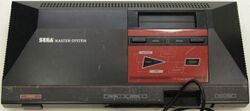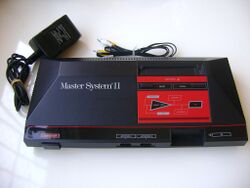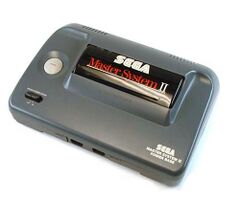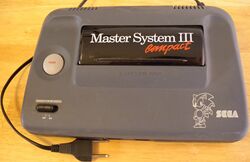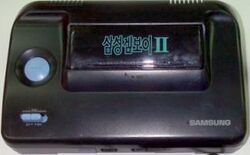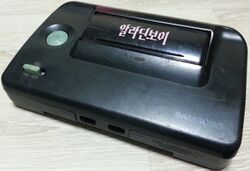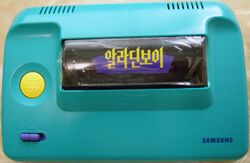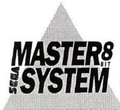Difference between revisions of "Sega Master System"
From Sega Retro
m (Text replacement - "maker=Sega" to "maker=Sega Enterprises, Ltd.") |
|||
| (90 intermediate revisions by 19 users not shown) | |||
| Line 1: | Line 1: | ||
{{ConsoleBob | {{ConsoleBob | ||
| − | | | + | | logo=Master System logo.svg |
| consoleimage=MasterSystem1.jpg | | consoleimage=MasterSystem1.jpg | ||
| − | + | | maker=[[Sega Enterprises, Ltd.]] | |
| − | | maker=[[Sega]] | + | | variants=[[Sega Mark III]], Sega Master System II, [[Sega Game Box 9]], [[Tectoy Master System Super Compact]], Samsung Gam-Boy, [[Sega System E]] |
| − | | variants=[[Sega Mark III]], Sega Master System II, [[Sega Game Box 9]], [[Tectoy Master System Super Compact]], | ||
| add-ons=[[Demo Unit II]], [[Telecon Pack]], [[3-D Glasses]] | | add-ons=[[Demo Unit II]], [[Telecon Pack]], [[3-D Glasses]] | ||
| internal_games=''[[Hang-On]]'', ''[[Hang-On / Safari Hunt]]'', ''[[Missile Defense 3-D]]'', ''[[Alex Kidd in Miracle World]]'', ''[[Sonic the Hedgehog (8-bit)|Sonic the Hedgehog]]'' | | internal_games=''[[Hang-On]]'', ''[[Hang-On / Safari Hunt]]'', ''[[Missile Defense 3-D]]'', ''[[Alex Kidd in Miracle World]]'', ''[[Sonic the Hedgehog (8-bit)|Sonic the Hedgehog]]'' | ||
| processor=[[Zilog Z80]] | | processor=[[Zilog Z80]] | ||
| releases={{releasesSMS | | releases={{releasesSMS | ||
| − | | sms_date_jp=1987-10-18 | + | | sms_date_jp=1987-10-18{{ref|https://web.archive.org/web/20201105232155/https://sega.jp/history/hard/mastersystem/index.html}} |
| sms_code_jp=MK-2000 | | sms_code_jp=MK-2000 | ||
| − | | sms_rrp_jp=16,800 | + | | sms_rrp_jp=16,800{{ref|https://web.archive.org/web/20201105232155/https://sega.jp/history/hard/mastersystem/index.html}} |
| sms_date_us=1986-10 | | sms_date_us=1986-10 | ||
| − | | sms_rrp_us=150 | + | | sms_rrp_us=150 |
| − | | sms_date_de=1986-10 | + | | sms_date_de=1986-10-07{{magref|soft|1987-2|28}} |
| − | | sms_rrp_de= | + | | sms_rrp_de=299 |
| sms_date_it=1986-11 | | sms_date_it=1986-11 | ||
| sms_rrp_it=300,000 | | sms_rrp_it=300,000 | ||
| − | | sms_date_uk=1987-08{{fileref| | + | | sms_date_es=1987-06{{magref|micromania|23|60}} |
| − | | sms_rrp_uk=99.95{{ | + | | sms_rrp_es=29,900 |
| + | | sms_date_uk=1987-08{{fileref|NottinghamEveningPost UK 1987-08-20 page 35.png}}{{magref|cvg|73|132}} | ||
| + | | sms_rrp_uk=99.95{{magref|ace|1|19}}{{magref|cvg|73|132}}{{magref|cvg|77|26}} | ||
| sms_date_fr=1987-09 | | sms_date_fr=1987-09 | ||
| + | | sms_code_fr=3005-09-A | ||
| sms_rrp_fr=990 | | sms_rrp_fr=990 | ||
| − | | sms_date_br=1989-09-04 | + | | sms_date_br=1989-09-04{{ref|1=http://web.archive.org/web/20120323135328/http://www.tectoy.com.br/tecblog/?p=359}} |
| − | | sms_rrp_br= 1,500 | + | | sms_rrp_br=1,500 |
| sms_date_kr=1989-04 | | sms_date_kr=1989-04 | ||
| sms_rrp_kr=119,000 | | sms_rrp_kr=119,000 | ||
| − | | sms_date_as= | + | | sms_date_as=1986 |
| sms_date_au=1986 | | sms_date_au=1986 | ||
| − | | sms_date_ar= | + | | sms_date_ar=1992 |
| − | | sms_date_za= | + | | sms_date_za=198x |
| − | | sms_date_mx= | + | | sms_date_mx=1990 |
| + | | sms_date_pt=1991 | ||
| + | | sms_code_pt=MSJ9027 | ||
| + | | sms_date_cs=1988{{ref|https://web.archive.org/web/20201021112513/https://www.telecompaper.com/news/video-games-market-small--23097}} | ||
| + | | sms_date_yu=1990 | ||
| + | | sms_rrp_yu=2100 | ||
| + | | sms_date_nl=1986-11 | ||
| + | | sms_rrp_nl=345 | ||
| + | | sms_date_cz_SMS II=1992-10 | ||
| + | | sms_rrp_cz_SMS II=2,949{{magref|abc|37-16|31}} | ||
}} | }} | ||
}} | }} | ||
| − | The '''Sega Master System''' (セガ・マスターシステム) or '''SMS''', is a cartridge-based video game console manufactured by [[Sega]]. It is a rebranding of the [[Sega Mark III]] intended for western markets, which in turn was a successor to the [[SG-1000]] and [[SG-1000 II]]. In South Korea the Master System was distributed by [[Samsung]] and known as the '''Gam*Boy''' (겜보이) and later '''Aladdin Boy''' (알라딘 보이). It was codenamed the '''Sega Mark IV''' during development. | + | <section begin=intro />The '''Sega Master System''' (セガ・マスターシステム) or '''SMS''', is a [[cartridge]]-based video game console manufactured by [[Sega]]. It is a rebranding of the [[Sega Mark III]] intended for western markets, which in turn was a successor to the [[SG-1000]] and [[SG-1000 II]]. In South Korea the Master System was distributed by [[Samsung]] and known as the '''Gam*Boy''' (겜보이) and later '''Aladdin Boy''' (알라딘 보이). It was codenamed the '''Sega Mark IV''' during development. |
| − | The Sega Master System was the first of Sega's consoles to see widespread distribution outside of Japan, and went head-to-head with the [[Nintendo]] | + | The Sega Master System was the first of Sega's consoles to see widespread distribution outside of Japan, and went head-to-head with the [[Nintendo|Nintendo Entertainment System]] (the international version of the Famicom) across the world. Sega was unsuccessful at dethroning Nintendo in the key markets of Japan and North America. However, significant sales in Europe and South America saw the console match and outsell the NES in those regions respectively, and supported as late as the mid-1990s in Europe and through to the present day in Brazil, receiving a large library of software in those regions. It is Sega's second most successful video game console of all time, with an estimated 20 million units sold worldwide, largely in Brazil and Europe.{{ref|[[wikia:w:c:vgsales:Third generation of video games|Third generation of video games]]}}<section end=intro /> |
| − | The | + | The console was originally marketed as the '''Sega Video Game System''' or just the '''Sega System''' at launch, with "Master System" being the name of the launch bundle available in North America, which was followed by the deluxe "SegaScope 3-D System" set and the budget-priced "Base System" set. The bundles were named differently in Europe, with the Master System bundle being the equivalent of the budget Base System, followed by the Master System Plus and the Super System. Because the "Master System" was the most prevalent bundle in most regions and the fact that all the consoles had "Master System/Power Base" printed on them, it became the defacto name for the platform following the Sega Master System II redesign. |
The [[Sega System E]] is an [[arcade]] board based on the Master System. The console was succeeded by the [[Sega Mega Drive]] (Genesis), which gained wider worldwide success. | The [[Sega System E]] is an [[arcade]] board based on the Master System. The console was succeeded by the [[Sega Mega Drive]] (Genesis), which gained wider worldwide success. | ||
| Line 46: | Line 57: | ||
The hardware builds on the design of the SG-1000, and so is completely backwards compatible with the older console. While on a technical level this also means a degree of [[SC-3000]] support, no versions of the Master System were ever designed with the ability to expand into a home computer. | The hardware builds on the design of the SG-1000, and so is completely backwards compatible with the older console. While on a technical level this also means a degree of [[SC-3000]] support, no versions of the Master System were ever designed with the ability to expand into a home computer. | ||
| − | The Master System is a hybrid 8/16-bit console. Its CPU, a [[Zilog Z80]], has an | + | The Master System is a hybrid 8/16-bit console. Its CPU, a [[Zilog Z80]], has an 8-bit data bus with both 8-bit and 16-bit registers, while its [[VDP]] is an 8/16-bit graphics processor, with a 16-bit data bus and using 8-bit and 16-bit registers. This combination of an 8-bit CPU with a 16-bit graphics processor was a precursor to the [[nec:PC Engine|PC Engine]] ([[nec:TurboGrafx-16|TurboGrafx-16]]), a more powerful console that released in 1987 and began the 16-bit era, leading to the creation of the [[Sega Mega Drive]] (Genesis). |
| − | |||
| − | |||
| − | |||
| − | |||
===Models=== | ===Models=== | ||
| Line 64: | Line 71: | ||
Unlike the NES, the Master System displays an instructional screen if the system is turned on without having a cart or card inserted, though as Sega moved to using built-in software, the console instead began to automatically load the built-in game instead. Early original Master Systems also contain the "easter egg" ''[[Snail Maze]]'' minigame - these earlier revisions of the console's BIOS are known to have trouble playing some later cartridges, including games published by [[Codemasters]] and later Brazillian releases by [[Tec Toy]]. | Unlike the NES, the Master System displays an instructional screen if the system is turned on without having a cart or card inserted, though as Sega moved to using built-in software, the console instead began to automatically load the built-in game instead. Early original Master Systems also contain the "easter egg" ''[[Snail Maze]]'' minigame - these earlier revisions of the console's BIOS are known to have trouble playing some later cartridges, including games published by [[Codemasters]] and later Brazillian releases by [[Tec Toy]]. | ||
| − | The 1987 Japanese release, whose design was also brought to South Korea, makes a number of important changes. Aside | + | The 1987 Japanese release, whose design was also brought to South Korea, makes a number of important changes. Aside a different cartridge slot, it has the Mark III's [[FM Sound Unit]] and [[Rapid Fire Unit]] built-in, and supports the [[3D Glasses]] without the need for an adapter (which usually plugs into the card slot). However, Korean consoles do not have FM sound. |
| − | Japanese Master Systems are | + | Japanese Master Systems are slightly tricky to spot, even though the cartridge size is smaller. They can be identified by the text on the left hand side of the unit - Western models read "Master System/Power Base", while Japanese systems simply read "Master System". In addition, they have a 3.5 mm jack on the front for connecting a pair of 3D glasses. |
| − | Master Systems have an expansion slot on the base of the system, in anticipation of future add-ons should Sega choose to release some. No such peripherals were ever released, and by mid-1990 Sega had conceded that the port had no practical purpose{{ | + | Master Systems have an expansion slot on the base of the system, in anticipation of future add-ons should Sega choose to release some. No such peripherals were ever released, and by mid-1990 Sega had conceded that the port had no practical purpose{{magref|sv|1|9}}. |
<gallery widths="250px" heights="200px"> | <gallery widths="250px" heights="200px"> | ||
MasterSystem1.jpg|North American/European model | MasterSystem1.jpg|North American/European model | ||
SMS Japan.jpg|Japanese model | SMS Japan.jpg|Japanese model | ||
| − | TectoyMasterSystem.jpg| | + | TectoyMasterSystem.jpg|Brazilian model (Master System) |
| − | TectoyMasterSystemII.jpg| | + | TectoyMasterSystemII.jpg|Brazilian model (Master System II) |
Samsunggamboy.jpg|South Korean model (Gam*Boy) | Samsunggamboy.jpg|South Korean model (Gam*Boy) | ||
</gallery> | </gallery> | ||
| Line 81: | Line 88: | ||
After a period of decline and the rise of the newly-released [[Sega Mega Drive]], Sega constructed the Sega Master System II for overseas markets. There is virtually no resemblance to the earlier model, opting for smooth curves and rounded corners more akin to the Mega Drive, and is a great deal smaller (and, as a result, cheaper to manufacture). | After a period of decline and the rise of the newly-released [[Sega Mega Drive]], Sega constructed the Sega Master System II for overseas markets. There is virtually no resemblance to the earlier model, opting for smooth curves and rounded corners more akin to the Mega Drive, and is a great deal smaller (and, as a result, cheaper to manufacture). | ||
| − | The Master System II removes many features (usually unpopular ones) in an effort to cut costs. There is no card port (and by extension, no 3D Glasses support), the unused expansion port was removed and the reset button has been omitted in favour of a larger pause button. The swinging, hinged cartridge slot doors of the original model are replaced with a sliding cover (which cannot be closed with a cartridge inserted), and the number of video output options reduced (usually to just RF). Also missing is a power LED and the BIOS | + | The Master System II removes many features (usually unpopular ones) in an effort to cut costs. There is no card port (and by extension, no 3D Glasses support), the unused expansion port was removed and the reset button has been omitted in favour of a larger pause button. The swinging, hinged cartridge slot doors of the original model are replaced with a sliding cover (which cannot be closed with a cartridge inserted), and the number of video output options reduced (usually to just RF). Also missing is a power LED and an animated BIOS screen; the BIOS just displays a simple Sega logo over a black background before the game starts. |
| − | Each region has its own set of cosmetic differences. In Brazil the system is known as the Master System III Compact | + | Each region has its own set of cosmetic differences. In Mercosur region (Brazil, Argentina, Paraguay and Uruguay) the system is known as the Master System III Compact and it was also released in some of the European states after model 2 discontinued (like Greece, Portugal, Spain). In South Korea it was released three times, first as the Gam*Boy II, second as the Aladdin Boy and third with blue color. |
All Master System IIs either included ''[[Alex Kidd (game series)|Alex Kidd in Miracle World]]'' as a built-in game, or ''[[Sonic the Hedgehog]]'', which arrived in 1991. | All Master System IIs either included ''[[Alex Kidd (game series)|Alex Kidd in Miracle World]]'' as a built-in game, or ''[[Sonic the Hedgehog]]'', which arrived in 1991. | ||
| Line 90: | Line 97: | ||
MasterSystem2.jpg|European model | MasterSystem2.jpg|European model | ||
MS3Compact.JPG|Brazilian model (Master System III Compact) | MS3Compact.JPG|Brazilian model (Master System III Compact) | ||
| − | Samsunggamboy2.jpg|South Korean model ( | + | Samsunggamboy2.jpg|South Korean model (Gam*Boy II) |
| − | AladdinBoy | + | AladdinBoy KR Black.jpg|South Korean model (Aladdin Boy) |
| + | AladdinBoy Blue.jpg|South Korean model (Blue release) | ||
</gallery> | </gallery> | ||
| Line 128: | Line 136: | ||
*pin 9: Button 2 | *pin 9: Button 2 | ||
| − | = | + | ===Technical specifications=== |
| − | + | {{mainArticle|Sega Master System/Technical specifications}} | |
| − | |||
| − | |||
| − | |||
| − | ==Technical specifications= | ||
| − | |||
| − | |||
| − | |||
| − | |||
| − | |||
| − | |||
| − | |||
| − | |||
| − | |||
| − | |||
| − | |||
| − | |||
| − | |||
| − | |||
| − | |||
| − | |||
| − | |||
| − | |||
| − | |||
| − | |||
| − | |||
| − | |||
| − | |||
| − | |||
| − | |||
| − | |||
| − | |||
| − | |||
| − | |||
| − | |||
| − | |||
| − | |||
| − | |||
| − | |||
| − | |||
| − | |||
| − | |||
| − | |||
| − | |||
| − | |||
| − | |||
| − | |||
| − | |||
| − | |||
| − | |||
| − | |||
| − | |||
| − | |||
| − | |||
| − | |||
| − | |||
| − | |||
| − | |||
| − | |||
| − | |||
| − | |||
| − | |||
| − | |||
| − | |||
| − | |||
| − | |||
| − | |||
| − | |||
| − | |||
| − | |||
| − | |||
| − | |||
| − | |||
| − | |||
| − | |||
| − | |||
| − | |||
| − | |||
| − | |||
| − | |||
| − | |||
| − | |||
| − | + | ===Comparison=== | |
| − | + | :''Main article: [[Sega Master System/Hardware comparison]]'' | |
| − | |||
| − | |||
| − | |||
| − | |||
| − | |||
| − | |||
| − | |||
| − | + | As was tradition with Sega consoles at the time, the handheld [[Sega Game Gear]] is backwards compatible with the Master System and can run Master System carts through an adapter. The only hardware difference known between the two on a chip level is that the Game Gear can define 4096 possible colors, while the Master System can only define 64 colors. Since the Game Gear has a larger total color palette, it uses a different palette format with 12-bit entries (two bytes each), whereas the Master System uses 6-bit entries (one byte each). Hence, while Game Gear games will technically run on a Master System, they will have incorrect colors. (This excludes a few Game Gear titles that are actually Master System games. These titles use the Master System compatibility mode and don't take advantage of any Game Gear-specific functionality.) | |
| − | |||
| − | |||
| − | |||
| − | |||
| − | |||
| − | |||
| − | |||
| − | |||
| − | |||
| − | |||
| − | |||
| − | |||
| − | |||
| − | |||
| − | |||
| − | |||
| − | + | Another hardware difference is [[resolution]]. The Game Gear's display is a 160x144 window in the Master System's 256x192 display. | |
| − | |||
| − | |||
| − | |||
| − | |||
| − | |||
| − | |||
| − | |||
| − | |||
| − | |||
| − | |||
| − | |||
| − | |||
| − | |||
| − | + | The lack of a "Start" button on a Master System also prevents many Game Gear games from being played without minor changes, since the game requires the user to press "Start" before progressing past the title screen. | |
| − | |||
| − | |||
| − | |||
| − | |||
| − | |||
| − | |||
| − | |||
| − | |||
| − | |||
| − | |||
| − | |||
| − | + | Its main rival was the [[NES]], an entirely 8-bit console. The Master System was the more powerful console. | |
| − | |||
| − | |||
| − | |||
| − | |||
| − | |||
| − | |||
| − | |||
| − | |||
| − | |||
| − | |||
| − | |||
| − | + | The Master System's main rivals in Europe were the home computers [[ZX Spectrum]], [[Commodore 64]] (C64), and [[Amiga|Commodore Amiga 500]] (A500), the latter releasing a month after the Master System's European release in 1987; though, despite the rivalry, Sega supported these platforms as a third-party licensor of arcade ports. The Master System was the most powerful 8-bit home system, surpassing the NES, ZX, and C64, while at the same time the SMS had a lower price point than the ZX and C64. | |
| − | |||
| − | |||
| − | |||
| − | |||
| − | |||
| − | |||
| − | |||
| − | |||
==History== | ==History== | ||
| Line 296: | Line 157: | ||
<!-- move somewhere --> | <!-- move somewhere --> | ||
===Sega RGB Cable=== | ===Sega RGB Cable=== | ||
| − | In France, the original Master System (and the SMS II, which had the A/V port instead of [[RF jack]]) were sold with an RGB lead (model 3085). One end plugs into the SMS, the other into the SCART/Peritel socket on a TV, via a small box in the lead, labeled 'Adapteur R.V.B.'. As it utilizes RGB, it gives a sharper and more vibrant picture compared to RF or composite video. The box contains a small PCB, the purpose of which is to provide | + | In France, the original Master System (and the SMS II, which had the A/V port instead of [[RF jack]]) were sold with an RGB lead (model 3085). One end plugs into the SMS, the other into the SCART/Peritel socket on a TV, via a small box in the lead, labeled 'Adapteur R.V.B.'. As it utilizes RGB, it gives a sharper and more vibrant picture compared to RF or composite video. The box contains a small PCB, the purpose of which is to amplify the RGB signals from the A/V port and provide blanking and function switching signals so that the TV can automatically switch to RGB input. |
==Games== | ==Games== | ||
| − | + | {{mainArticle|Sega Master System games}} | |
| − | {{ | ||
| − | == | + | ==Production credits== |
| − | === | + | ===American version=== |
| − | * '' | + | {{creditstable| |
| − | + | *'''Team Leader:''' [[Masami Ishikawa]] | |
| − | + | | source=Developer mentions{{ref|https://www.famitsu.com/news/201308/12038274.html}}{{ref|https://www.facebook.com/hiroyuki.ohtaka/about_work_and_education}} | |
| − | == | + | | console=SMS |
| − | + | | region=US | |
| − | === | + | }} |
| − | + | ===Japanese version=== | |
| − | * | + | {{creditstable| |
| − | + | *[[Hiroyuki Ohtaka]] | |
| − | + | | source=Developer mentions{{ref|https://www.famitsu.com/news/201308/12038274.html}}{{ref|https://www.facebook.com/hiroyuki.ohtaka/about_work_and_education}} | |
| − | + | | console=SMS | |
| − | + | | region=JP | |
| − | + | }} | |
==Magazine articles== | ==Magazine articles== | ||
| Line 322: | Line 182: | ||
==Promotional material== | ==Promotional material== | ||
| − | + | {{mainArticle|{{PAGENAME}}/Promotional material}} | |
| − | |||
| − | |||
| − | |||
| − | |||
| − | |||
| − | |||
| − | |||
| − | |||
| − | |||
| − | |||
| − | |||
| − | {{ | ||
| − | |{{ | ||
| − | |||
| − | }} | ||
| − | + | ==Logos by regions== | |
| − | + | {|class="prettytable sortable" style="background: #f2f2f2;" | |
| − | + | |- | |
| − | + | ! style="width:100px;" style="text-align: center;" |'''Logo''' | |
| − | + | ! style="width:100px;" style="text-align: center;" |'''Region''' | |
| − | | | + | |- style="background: silver;" |
| − | | | + | |- |
| − | + | |<gallery>Master System logo.svg</gallery> | |
| − | + | |International logo | |
| − | + | |- | |
| − | + | |<gallery>Notavailable.svg</gallery> | |
| − | + | |Shortly used in 1990 on game covers in North America | |
| − | + | |- | |
| − | + | |<gallery>Master System logo SE.png</gallery> | |
| − | + | |Used in Scandinavia | |
| − | + | |- | |
| − | + | |<gallery>Notavailable.svg</gallery> | |
| − | + | |Used in China/Hong Kong | |
| − | + | |- | |
| − | + | |<gallery>Notavailable.svg</gallery> | |
| − | + | |Used in Taiwan | |
| − | + | |- | |
| − | + | |<gallery>Notavailable.svg</gallery> | |
| − | + | |Used in South Korea | |
| − | + | |- | |
| − | + | |<gallery>SMSII Logo GCC Arabic.png</gallery> | |
| − | + | |Used in the Arabian Peninsula | |
| − | + | |- | |
| − | + | |} | |
| − | |||
| − | |||
| − | |||
| − | |||
| − | |||
| − | |||
| − | |||
| − | |||
| − | |||
| − | |||
| − | |||
| − | |||
| − | |||
| − | |||
| − | |||
| − | |||
| − | |||
| − | |||
| − | |||
| − | |||
| − | |||
| − | |||
| − | |||
| − | |||
| − | |||
| − | |||
| − | |||
| − | |||
| − | |||
| − | |||
| − | |||
| − | |||
| − | |||
| − | |||
| − | |||
| − | |||
| − | |||
| − | | | ||
| − | |||
| − | |||
| − | | | ||
| − | |||
| − | |||
| − | |||
| − | |||
| − | | | ||
| − | |||
| − | |||
| − | |||
| − | |||
| − | |||
| − | |||
| − | |||
| − | |||
| − | |||
| − | |||
| − | | | ||
| − | |||
| − | |||
| − | |||
| − | |||
| − | |||
| − | |||
| − | |||
| − | |||
| − | |||
| − | |||
| − | |||
| − | |||
| − | |||
| − | |||
| − | |||
| − | |||
| − | |||
| − | |||
| − | |||
| − | |||
| − | |||
| − | |||
| − | |||
| − | |||
| − | |||
| − | |||
| − | |||
| − | |||
| − | |||
| − | |||
| − | |||
| − | |||
| − | |||
| − | |||
| − | |||
| − | |||
| − | |||
| − | |||
| − | | | ||
| − | | | ||
| − | | | ||
| − | |||
| − | |||
| − | |||
| − | |||
| − | | | ||
| − | | | ||
| − | | | ||
| − | |||
| − | |||
| − | | | ||
| − | | | ||
| − | | | ||
| − | | | ||
| − | |||
| − | |||
| − | |||
| − | |||
| − | | | ||
| − | |||
| − | |||
| − | |||
| − | | | ||
| − | | | ||
| − | | | ||
| − | |||
| − | |||
| − | |||
| − | |||
| − | |||
| − | | | ||
| − | |||
| − | | | ||
| − | |||
| − | |||
| − | |||
| − | |||
| − | <gallery> | ||
| − | |||
| − | |||
| − | </gallery> | ||
| − | |||
| − | |||
| − | |||
| − | |||
| − | |||
| − | |||
| − | |||
| − | |||
| − | |||
==External links== | ==External links== | ||
| − | *[http://www.smspower.org SMS Power] | + | * [https://sega.jp/history/hard/mastersystem/index.html Sega of Japan catalogue page (Japanese)] |
| + | * [http://www.smspower.org SMS Power] | ||
==References== | ==References== | ||
| − | |||
<references /> | <references /> | ||
| − | |||
{{Sega Consoles}} | {{Sega Consoles}} | ||
Latest revision as of 08:02, 16 November 2024

| ||||||||||||||||||||||||||||||||||||||||||||||||||||||||||||||||||||||||||||||||||||||||||
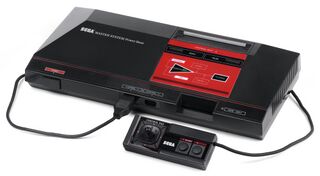
| ||||||||||||||||||||||||||||||||||||||||||||||||||||||||||||||||||||||||||||||||||||||||||
| Sega Master System | ||||||||||||||||||||||||||||||||||||||||||||||||||||||||||||||||||||||||||||||||||||||||||
|---|---|---|---|---|---|---|---|---|---|---|---|---|---|---|---|---|---|---|---|---|---|---|---|---|---|---|---|---|---|---|---|---|---|---|---|---|---|---|---|---|---|---|---|---|---|---|---|---|---|---|---|---|---|---|---|---|---|---|---|---|---|---|---|---|---|---|---|---|---|---|---|---|---|---|---|---|---|---|---|---|---|---|---|---|---|---|---|---|---|---|
| Manufacturer: Sega Enterprises, Ltd. | ||||||||||||||||||||||||||||||||||||||||||||||||||||||||||||||||||||||||||||||||||||||||||
| Variants: Sega Mark III, Sega Master System II, Sega Game Box 9, Tectoy Master System Super Compact, Samsung Gam-Boy, Sega System E | ||||||||||||||||||||||||||||||||||||||||||||||||||||||||||||||||||||||||||||||||||||||||||
| Add-ons: Demo Unit II, Telecon Pack, 3-D Glasses | ||||||||||||||||||||||||||||||||||||||||||||||||||||||||||||||||||||||||||||||||||||||||||
| Built-in games: Hang-On, Hang-On / Safari Hunt, Missile Defense 3-D, Alex Kidd in Miracle World, Sonic the Hedgehog | ||||||||||||||||||||||||||||||||||||||||||||||||||||||||||||||||||||||||||||||||||||||||||
|
The Sega Master System (セガ・マスターシステム) or SMS, is a cartridge-based video game console manufactured by Sega. It is a rebranding of the Sega Mark III intended for western markets, which in turn was a successor to the SG-1000 and SG-1000 II. In South Korea the Master System was distributed by Samsung and known as the Gam*Boy (겜보이) and later Aladdin Boy (알라딘 보이). It was codenamed the Sega Mark IV during development.
The Sega Master System was the first of Sega's consoles to see widespread distribution outside of Japan, and went head-to-head with the Nintendo Entertainment System (the international version of the Famicom) across the world. Sega was unsuccessful at dethroning Nintendo in the key markets of Japan and North America. However, significant sales in Europe and South America saw the console match and outsell the NES in those regions respectively, and supported as late as the mid-1990s in Europe and through to the present day in Brazil, receiving a large library of software in those regions. It is Sega's second most successful video game console of all time, with an estimated 20 million units sold worldwide, largely in Brazil and Europe.[11]
The console was originally marketed as the Sega Video Game System or just the Sega System at launch, with "Master System" being the name of the launch bundle available in North America, which was followed by the deluxe "SegaScope 3-D System" set and the budget-priced "Base System" set. The bundles were named differently in Europe, with the Master System bundle being the equivalent of the budget Base System, followed by the Master System Plus and the Super System. Because the "Master System" was the most prevalent bundle in most regions and the fact that all the consoles had "Master System/Power Base" printed on them, it became the defacto name for the platform following the Sega Master System II redesign.
The Sega System E is an arcade board based on the Master System. The console was succeeded by the Sega Mega Drive (Genesis), which gained wider worldwide success.
Contents
Hardware
The Master System is essentially a rebadged Sega Mark III and so shares the majority of the same traits as Sega's earlier console. Like the Mark III and SG-1000, it is designed to play video games distributed on ROM cartridges (or Sega Card) through a compatible television.
The hardware builds on the design of the SG-1000, and so is completely backwards compatible with the older console. While on a technical level this also means a degree of SC-3000 support, no versions of the Master System were ever designed with the ability to expand into a home computer.
The Master System is a hybrid 8/16-bit console. Its CPU, a Zilog Z80, has an 8-bit data bus with both 8-bit and 16-bit registers, while its VDP is an 8/16-bit graphics processor, with a 16-bit data bus and using 8-bit and 16-bit registers. This combination of an 8-bit CPU with a 16-bit graphics processor was a precursor to the PC Engine (TurboGrafx-16), a more powerful console that released in 1987 and began the 16-bit era, leading to the creation of the Sega Mega Drive (Genesis).
Models
- Main article: Master System consoles.
Master System
The original 1986 model Sega Master System took a radically different approach to its outward design to the Mark III, released a year prior. The main unit, commonly referred to as the "Power Base" is a black 3D trapezium with red/orange highlights, measuring 143/8 inches in width, 65/8 inches deep and 23/4 inches in height. After a one-inch base, the machine is formed upward and inward to form the cartridge slot plateau.
The Master System takes much of its design cues from the Nintendo Entertainment System (NES), released in 1983 in Japan and 1985 in the US, with detachable controllers and power and reset buttons. But like prior Sega consoles (and virtually all cartridge-based systems going forward), the Master System is a top-loading machine. It also contains a card slot for the handful of games distributed on Sega Card, and curiously, a diagram or vague instructions as to how the system works (i.e. insert a cartridge, power the system on, and use the control pads to manipulate an image on a television screen). The Master System also has a built-in "pause" button for stopping play.
The Master System has an introduction screen which appears each time the system is turned on (with or without a game inserted). The Sega logo slowly "slides" into view mid-screen (with accompanying sound effect), and the text "Master System" appears underneath, with the two-tone "Sega" tune also being played during this sequence.
Unlike the NES, the Master System displays an instructional screen if the system is turned on without having a cart or card inserted, though as Sega moved to using built-in software, the console instead began to automatically load the built-in game instead. Early original Master Systems also contain the "easter egg" Snail Maze minigame - these earlier revisions of the console's BIOS are known to have trouble playing some later cartridges, including games published by Codemasters and later Brazillian releases by Tec Toy.
The 1987 Japanese release, whose design was also brought to South Korea, makes a number of important changes. Aside a different cartridge slot, it has the Mark III's FM Sound Unit and Rapid Fire Unit built-in, and supports the 3D Glasses without the need for an adapter (which usually plugs into the card slot). However, Korean consoles do not have FM sound.
Japanese Master Systems are slightly tricky to spot, even though the cartridge size is smaller. They can be identified by the text on the left hand side of the unit - Western models read "Master System/Power Base", while Japanese systems simply read "Master System". In addition, they have a 3.5 mm jack on the front for connecting a pair of 3D glasses.
Master Systems have an expansion slot on the base of the system, in anticipation of future add-ons should Sega choose to release some. No such peripherals were ever released, and by mid-1990 Sega had conceded that the port had no practical purpose[12].
Master System II
After a period of decline and the rise of the newly-released Sega Mega Drive, Sega constructed the Sega Master System II for overseas markets. There is virtually no resemblance to the earlier model, opting for smooth curves and rounded corners more akin to the Mega Drive, and is a great deal smaller (and, as a result, cheaper to manufacture).
The Master System II removes many features (usually unpopular ones) in an effort to cut costs. There is no card port (and by extension, no 3D Glasses support), the unused expansion port was removed and the reset button has been omitted in favour of a larger pause button. The swinging, hinged cartridge slot doors of the original model are replaced with a sliding cover (which cannot be closed with a cartridge inserted), and the number of video output options reduced (usually to just RF). Also missing is a power LED and an animated BIOS screen; the BIOS just displays a simple Sega logo over a black background before the game starts.
Each region has its own set of cosmetic differences. In Mercosur region (Brazil, Argentina, Paraguay and Uruguay) the system is known as the Master System III Compact and it was also released in some of the European states after model 2 discontinued (like Greece, Portugal, Spain). In South Korea it was released three times, first as the Gam*Boy II, second as the Aladdin Boy and third with blue color.
All Master System IIs either included Alex Kidd in Miracle World as a built-in game, or Sonic the Hedgehog, which arrived in 1991.
Internals
RF Converter: MGB3-VU3401, 8E388 PCB Component Side Markings: (c) SEGA 1988 : SEGA (R) M4 POWERBASE / NTSC 171-5533-01 : 837-6629 19 AUG 1988 CON2: 35 Pin Card Slot 209-5020 K16R CON3: 50 Pin Cartridge Slot PSB4D255-4R1 M18R CON4: 50 Pin Card Edge IC1: Zilog Z0840004PSC Z80CPU 8828 SL0965 IC2: 0821EX SEGA MPR-11460 W46 IC3: NEC JAPAN D4168C-20 8829P5007 IC4: SEGA (R) 315-5216 120U 8820 Z79 IC5: SEGA 315-5124 2602B 84 18 89 B IC6: NEC JAPAN D4168C-15-SG 8828XX215 IC7: NEC JAPAN D4168C-15-SG 8828XX215 IC9: SONY 8M09 CXA1145
SMS Control Pad Information:
- female plug on end view:
5 4 3 2 1 9 8 7 6
- pin 1: Up
- pin 2: Down
- pin 3: Left
- pin 4: Right
- pin 5: No Connection
- pin 6: Button 1 (Start)
- pin 7: No Connection
- pin 8: Common (Ground)
- pin 9: Button 2
Technical specifications
- Main article: Sega Master System/Technical specifications.
Comparison
- Main article: Sega Master System/Hardware comparison
As was tradition with Sega consoles at the time, the handheld Sega Game Gear is backwards compatible with the Master System and can run Master System carts through an adapter. The only hardware difference known between the two on a chip level is that the Game Gear can define 4096 possible colors, while the Master System can only define 64 colors. Since the Game Gear has a larger total color palette, it uses a different palette format with 12-bit entries (two bytes each), whereas the Master System uses 6-bit entries (one byte each). Hence, while Game Gear games will technically run on a Master System, they will have incorrect colors. (This excludes a few Game Gear titles that are actually Master System games. These titles use the Master System compatibility mode and don't take advantage of any Game Gear-specific functionality.)
Another hardware difference is resolution. The Game Gear's display is a 160x144 window in the Master System's 256x192 display.
The lack of a "Start" button on a Master System also prevents many Game Gear games from being played without minor changes, since the game requires the user to press "Start" before progressing past the title screen.
Its main rival was the NES, an entirely 8-bit console. The Master System was the more powerful console.
The Master System's main rivals in Europe were the home computers ZX Spectrum, Commodore 64 (C64), and Commodore Amiga 500 (A500), the latter releasing a month after the Master System's European release in 1987; though, despite the rivalry, Sega supported these platforms as a third-party licensor of arcade ports. The Master System was the most powerful 8-bit home system, surpassing the NES, ZX, and C64, while at the same time the SMS had a lower price point than the ZX and C64.
History
- Main article: History of the Sega Master System.
Sega RGB Cable
In France, the original Master System (and the SMS II, which had the A/V port instead of RF jack) were sold with an RGB lead (model 3085). One end plugs into the SMS, the other into the SCART/Peritel socket on a TV, via a small box in the lead, labeled 'Adapteur R.V.B.'. As it utilizes RGB, it gives a sharper and more vibrant picture compared to RF or composite video. The box contains a small PCB, the purpose of which is to amplify the RGB signals from the A/V port and provide blanking and function switching signals so that the TV can automatically switch to RGB input.
Games
- Main article: Sega Master System games.
Production credits
American version
- Team Leader: Masami Ishikawa
Japanese version
Magazine articles
- Main article: Sega Master System/Magazine articles.
Promotional material
- Main article: Sega Master System/Promotional material.
Logos by regions
| Logo | Region |
|---|---|
| International logo | |
| Shortly used in 1990 on game covers in North America | |
| Used in Scandinavia | |
| Used in China/Hong Kong | |
| Used in Taiwan | |
| Used in South Korea | |
| Used in the Arabian Peninsula |
External links
References
- ↑ 1.0 1.1 https://sega.jp/history/hard/mastersystem/index.html (Wayback Machine: 2020-11-05 23:21)
- ↑ Soft, "" (DK; 1987-02-19), page 28
- ↑ Micromanía, "Mayo 1987" (ES; 1987-xx-xx), page 60
- ↑ File:NottinghamEveningPost UK 1987-08-20 page 35.png
- ↑ 5.0 5.1 Computer & Video Games, "November 1987" (UK; 1987-10-15), page 132
- ↑ ACE, "October 1987" (UK; 1987-09-xx), page 19
- ↑ Computer & Video Games, "March 1988" (UK; 1988-02-15), page 26
- ↑ http://www.tectoy.com.br/tecblog/?p=359 (Wayback Machine: 2012-03-23 13:53)
- ↑ https://www.telecompaper.com/news/video-games-market-small--23097 (Wayback Machine: 2020-10-21 11:25)
- ↑ ABC, "Ročník 37, 16" (CZ; 1993-04-24), page 31
- ↑ Third generation of video games
- ↑ Sega Visions, "June/July 1990" (US; 1990-xx-xx), page 9
- ↑ 13.0 13.1 https://www.famitsu.com/news/201308/12038274.html
- ↑ 14.0 14.1 https://www.facebook.com/hiroyuki.ohtaka/about_work_and_education
| Sega Home Video Game Systems | ||||||||||||||||||||||||||||
| 83 | 84 | 85 | 86 | 87 | 88 | 89 | 90 | 91 | 92 | 93 | 94 | 95 | 96 | 97 | 98 | 99 | 00 | 01 | 02 | 03 | 04 | 05 | 06 | 07 | 08 | 09 | 10 | 11 |
|---|---|---|---|---|---|---|---|---|---|---|---|---|---|---|---|---|---|---|---|---|---|---|---|---|---|---|---|---|
| SG-1000 | SG-1000 II | Mega Drive | Mega Drive II | |||||||||||||||||||||||||
| SC-3000 | Mega-CD | Mega-CD II | Genesis 3 | |||||||||||||||||||||||||
| Sega Mark III | 32X | Dreamcast | ||||||||||||||||||||||||||
| Master System | Master System II | |||||||||||||||||||||||||||
| AI Computer | Game Gear | |||||||||||||||||||||||||||
| Saturn | ||||||||||||||||||||||||||||
| Pico | Beena | |||||||||||||||||||||||||||
| Sega Master System | |
|---|---|
| Topics | Sega Master System | Technical Specifications (Hardware Comparison) | History | Boot ROM | Magazine articles | Promotional material | Merchandise |
| Hardware | Asia | North America | Western Europe | Eastern Europe | South America | Australasia | Africa Sega Mark III | Sega Game Box 9 | Master System Girl | Master System Super Compact | Kiosk | Sega System E |
| Add-ons | Demo Unit II | Telecon Pack | FM Sound Unit | 3-D Glasses |
| Controllers | SJ-152 | Control Pad | 3-D Glasses | Control Stick | Handle Controller | Light Phaser | Paddle Control | Rapid Fire Unit | Sports Pad | SG Commander |
| Misc. Hardware | Action Replay | Card Catcher | Action Case | Freedom Connection | Playkit |
| Unreleased | Floppy Disk Drive |
| Consoles-on-a-chip | Arcade Gamer Portable | TF-DVD560 | DVD Karaoke Game DVT-G100 | Fun Play 20-in-1 | Handheld Electronic Games | Master System 3 Collection | Master System 3 | Master System Evolution | Master System Handy | PlayPal Plug & Play | Poga |
- JP Master System hardware
- US Master System hardware
- DE Master System hardware
- ES Master System hardware
- FR Master System hardware
- NL Master System hardware
- PT Master System hardware
- UK Master System hardware
- IT Master System hardware
- CZ Master System hardware
- AU Master System hardware
- MX Master System hardware
- AR Master System hardware
- BR Master System hardware
- KR Master System hardware
- AS Master System hardware
- ZA Master System hardware
- Master System hardware
- Bad external reference
- Credits without reference
- Sega Master System
